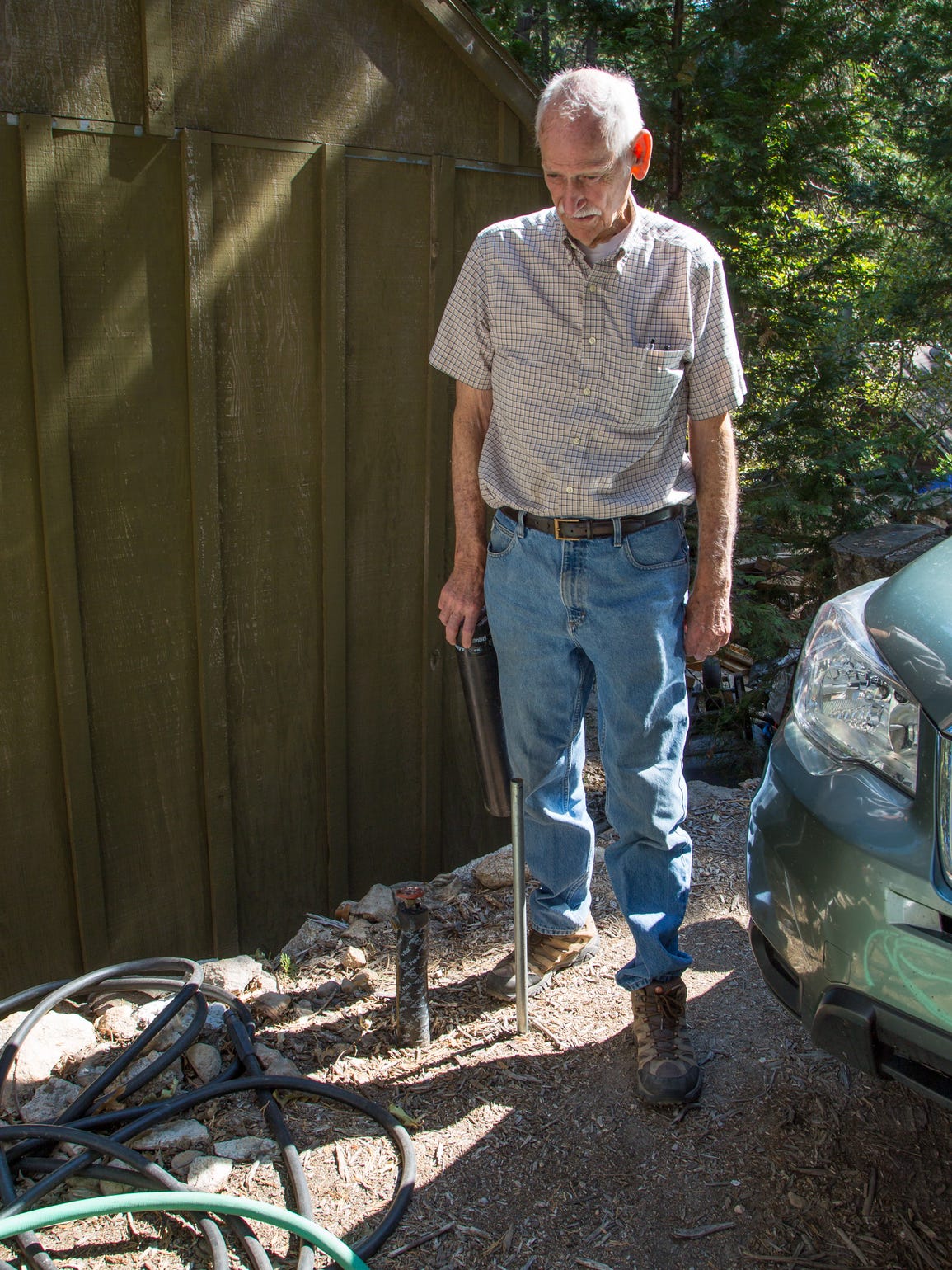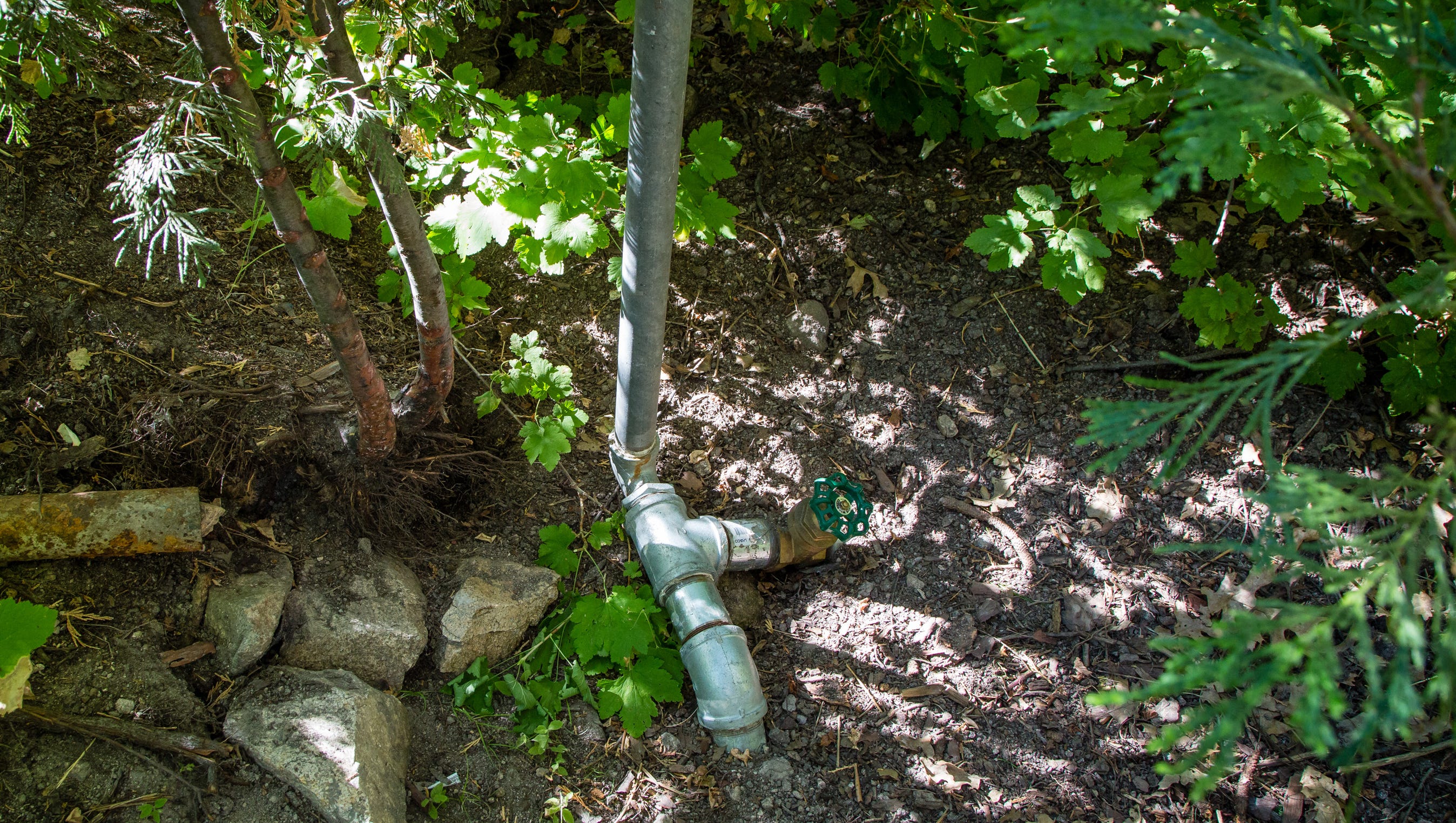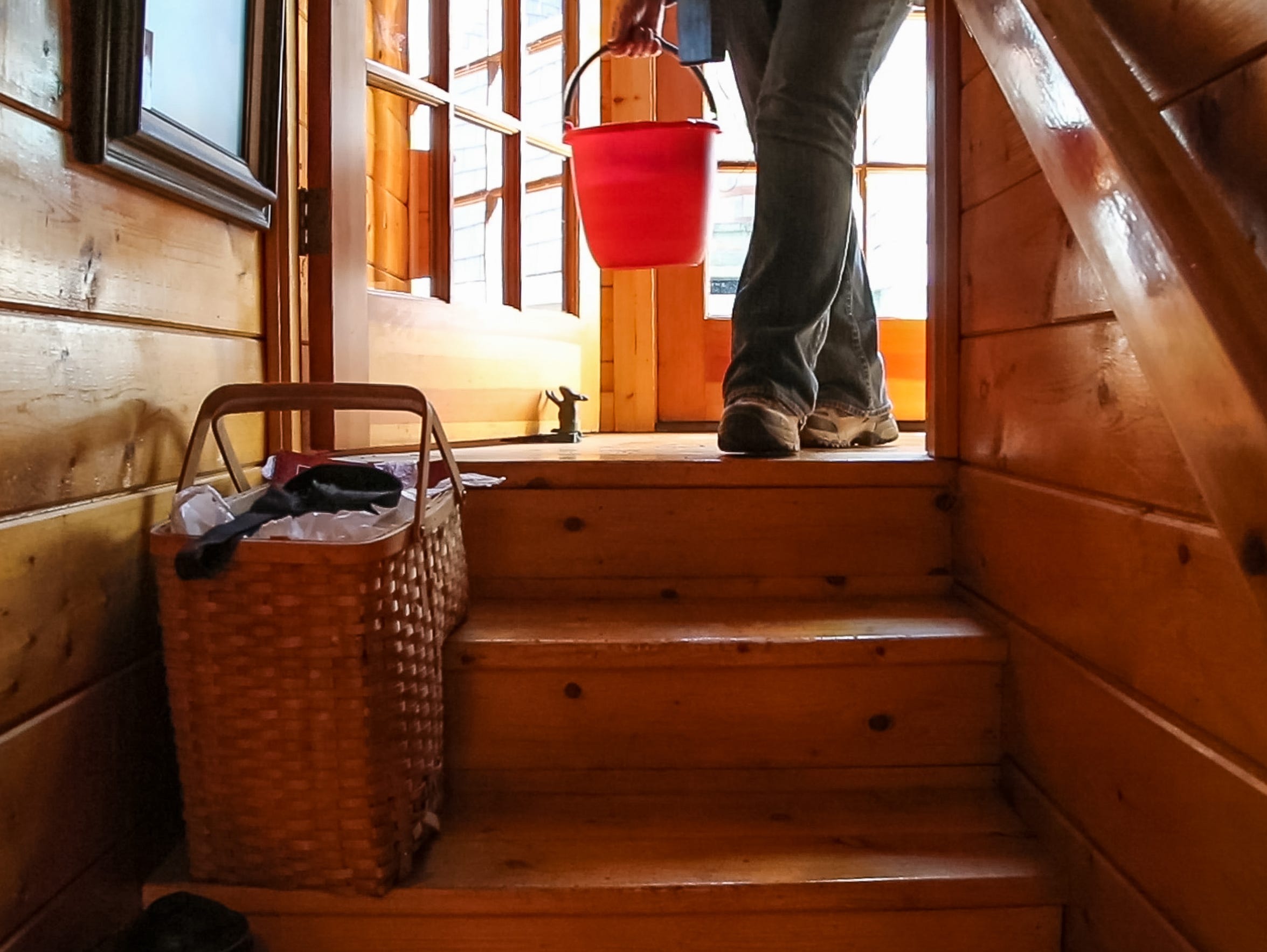In the San Bernardino Mountains, a couple lugs buckets as the flow from their well dwindles during a fifth year of drought...

Photo: Zoë Meyers/The Desert Sun
BLUE JAY, Calif. — In small communities scattered across California, more wells have been failing as the drought persists for a fifth year.
In parts of the Central Valley, entire neighborhoods have run dry and are relying on trucks to deliver water to refill tanks. State officials’ latest tally of homes with reported water supply problems stands at more than 2,300 statewide, and long-term projects to extend water pipes to homes with dry wells are just beginning.

Sharon and Don Bailey stand outside their home in Blue Jay in the San Bernardino Mountains. The Baileys have learned to use much less water since their well began to fail in February.
(Photo: Zoe Meyers/The Desert Sun)
In the San Bernardino Mountains, Sharon and Don Bailey used to take it for granted that they’d turn on a tap at home and water would flow out. Then they noticed the water pressure in their cabin was unusually low. Seven months ago, the flow decreased to the point that nothing came out.
To make do, they ran a hose from a neighboring house to theirs. They heated water in the microwave, poured it into a camping shower bag and carried it upstairs to bathe. They eventually repaired an old valve next to the well, and that helped get the water running again, but only about a fourth of the normal flow.
“We are saving every drop of water we can to avoid running out of water completely,” Sharon said, standing by her kitchen sink. “We’re hoping for rain someday to replenish the well.”
The Baileys have been limiting themselves to quick showers every other day. They take their clothes to a coin laundry and carry buckets of dishwater outside to pour on the scraggly plants that are barely holding on in their yard. Sometimes, the tap sputters.
In the San Bernardino Mountains, the winter snows have decreased dramatically and very little rain has fallen the past several years.
The Bailey's well relies on snowfall, which has greatly diminished in the past five years. To save water they've let many of the plants in their yard dry up.

(Photo: Zoë Meyers/The Desert Sun)
The Baileys have still enjoyed sitting in the backyard this summer as the hot, dry breezes have blown through the cedars, firs and oaks. But they’ve noticed the forest is changing around them. The brush has grown thinner. The grass in forest clearings has turned golden and crisp. Wildfires have raged through other parts of the mountains, leaving neighborhoods in ashes. Many trees have died.
“I definitely have been thinking about what effect climate change is having,” Sharon said. “We really think that climate change has a lot to do with it.”
While California and the West are naturally drought-prone and have experienced long-lasting mega-droughts in the past, scientists say global warming is packing an extra punch and exacerbating the drought.
Last year was the planet’s warmest on record, and the first seven months of this year have been the warmest worldwide since record-keeping began in 1880. California has had its hottest summer in recorded history.
Lugging buckets and waiting for drought fixes in the San Bernardino Mountains Zoe Meyers/The Desert Sun
Groundwater levels were already declining in the farmlands of the Central Valley before the drought, and heavy pumping the past few years has driven water tables even lower.
The state has been spending more than $650,000 a month delivering water to homes in the Central Valley community of East Porterville, where hundreds of wells have gone dry. State officials are working on a long-term fix, planning to connect 500 homes to Porterville’s city water system this year, and as many as 1,300 additional homes next year. Workers began connecting homes in East Porterville last month and have hooked up eight so far.

Don Bailey examines one of the water valves outside his home. Don has lived in the San Bernardino Mountains for about 30 years and until this year had never had problems with the water supply.
(Photo: Zoe Meyers/The Desert Sun)
In other areas where old infrastructure has collided with receding groundwater levels, homeowners are shouldering the costs of coping on their own.
Don, who is 81 and used to run a television sales and service business, has lived in the mountains full-time for three decades. Until this year, water flowed reliably from the well. But with much less rainfall and snowmelt replenishing the groundwater, the Baileys’ old well is no longer sufficient.
Their home in the unincorporated community of Blue Jay was built in 1929. Their horizontal well, which is gravity-fed and pulls water from the mountainside without a pump, once provided water for nearly a dozen homes.
Decades ago, many homeowners decided to pay to hook up to the municipal water system. Those who owned Don’s cabin at the time decided against it, and in later years his relatives didn’t see a need to connect either.
Today the well supplies two homes, some of the few in the area that aren’t connected to the network of water pipes.
Don Bailey replaced an old valve that controlled water flow from his well in February, when his home ran completely out of water. Since then he and his wife Sharon have had a limited supply of water coming into their home.

(Photo: Zoë Meyers/The Desert Sun)
After the well began to fail, Don called the local water agency to try to get hooked up. But he learned the Crestline-Lake Arrowhead Water Agency had among its drought measures a moratorium on new connections.
The agency’s board decided this month to lift that moratorium, which will enable the Baileys to apply to connect. It will cost them about $4,000. While waiting for that fix, the couple has learned to get by with much less water.
“I’ve just been watering enough to keep them going,” Sharon said as she walked among wilted and brown plants, lugging a bucket half-full with water from the kitchen.

Sharon Bailey carries a bucket of water she collected in her shower to water plants in her yard.
(Photo: Zoë Meyers/The Desert Sun)
Tipping the bucket, she poured a splash on a small fern. “I’m really babying my bracken fern.”
Sharon is an environmentalist and a plant lover. She used to work at a nursery, handling potted plants from chrysanthemums and poinsettias. Now 75 and retired, she finds the work of carrying water wears her down, yet she keeps at it.
“It’s really hard, and it makes it harder to get other things done,” she said. “But I guess trying to keep the plants alive is a priority.”
Sharon has also been speaking out recently against Nestle’s bottling of water from the nearby San Bernardino National Forest. Environmental groups are suing the U.S. Forest Service in an attempt to stop the company from piping water out of the forest. In June, Sharon joined activists in a protest outside the federal courthouse in Riverside, where they held a banner reading “Turn off the spigot.”

Less snow and rain have fallen in the San Bernardino Mountains during the past several years of drought.
(Photo: Zoe Meyers/The Desert Sun)
Nestle says its use of water from the forest isn’t causing any harm. The wells the company uses to collect water are located a few miles from the Balileys' home, on the other side of a steep mountain ridge.
Sharon said she doesn’t know whether the bottling operation might be having some effect on her well. But she said she’s concerned about the lack of water threatening wildlife in the forest — more concerned than she is about her water problems at home.
She’s learned to live with the inconveniences, catching water in a bucket during her brief showers. Sometimes, Sharon said, “you’re all soaped up and the shower is getting more and more of a trickle, and you’re just hoping that you’re going to have enough water to rinse the soap off with.”
Sharon said she isn’t dwelling on the question of what they would do if the water runs out completely.
“My attitude is, we’re pretty tough and pretty resourceful,” she said. “We just figure whatever happens, when it happens, we’ll deal with it.”
During the drought, the Baileys have seen the amount of water flowing from their well decrease dramatically. They've let much of their yard dry up, while keeping a few plants alive.

(Photo: Zoe Meyers/The Desert Sun)
Story by Ian James | Photos and video by Zoë Meyers, The Desert Sun
Ian James writes about water and the environment for The Desert Sun. He can be reached at [email protected], 760-778-4693 or @TDSIanJames.
source: http://www.desertsun.com/
original story HERE
Get more of The Global Warming Blog. Bookmark this page and sign up for the blog’s free RSS Feed. Sign up for free Global Warming Blog by clicking here. You will automatically be emailed a regular summary of the latest global warming headlines.

Be the first to comment
Sign in with